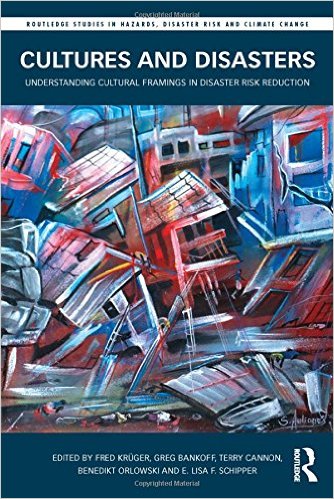
Fred Kruger, Greg Bankoff, Terry Cannon. Benedikt Orlowski, Lisa Schipper (Eds.) 2015
ISBN 978-0-415-74560-4
276 pages $56.95 (paperback)
Francis & Taylor
Book review by Zehra Zaidi
This collection of essays provides a much needed intervention in the field of disaster risk reduction. Its contributors represent some of the most eminent scholars in the field, providing insight into the socially embedded nature of risk and the contextual nature of people’s perceptions, interpretations, and reactions to hazards.
The book is comprised of 15 chapters, separated into three different themes. The first section deconstructs the notion of disasters from different social perspectives, and explores how cultural norms and values play a role in determining the existence or absence of risks. Arguments relating to disaster risk reduction as a manifestation of neoliberal politics, or of an increasingly security obsessed society highlight the influence of larger cultural paradigms in shaping modern thinking on disasters. Lessons on historical interpretations of disasters, often expressed through architecture and the built-environment, continue to offer learning opportunities for modern societies. Cultural beliefs and behavior can therefore be the seen as the lynchpin around which modern day vulnerability to disasters, especially in the context of climate change, is configured and projected. The following section examines aspects of culture that influence how risk and vulnerability are communicated and embedded into everyday practice. Drawing on frameworks as diverse as behavioral drivers, health, religious beliefs, and psychosocial trauma, each chapter highlights responses to disasters that are often discounted in favor of more hegemonic or technical solutions. By focusing on local or even individual triggers and responses to risk, the section builds the case for a more contextualized and culturally sensitive interpretation of disaster risk management that can offer new entry points into strengthening resilience. The last part of the book is an amalgamation of illustrative case studies examining the way in which implementation of disaster risk reduction initiatives is supported, transformed or rendered useless through interaction with cultural practices. From the ‘Geldof/Bono factor,’ to gendered capacities, objective versus subjective worlds, and the political nature of participation of both the DRR practitioner and the vulnerable, this section provides diverse and colorful examples to bring home the importance of cultural signifiers in regulating disaster management efforts.
One of the strong points of this book is that it does not attempt to reduce the concept of culture to a singular or universal notion. Instead, each contribution approaches culture in its own individual manner, reflecting the fluidity and plurality of how beliefs, attitudes, experiences, values, and day-to-day routines mediate the way in which societies interact with their risk environments. Disaster risk reduction studies and initiatives, coming from the perspective of security and safety, can often assume a position of rationality and scientific validity. This book serves as a reminder of how far we still need to go in understanding and incorporating the socially constructed nature of risk in the field of disasters – and, conveniently, lays out the beginnings of an agenda to get there.